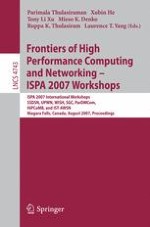2007 | Buch
Frontiers of High Performance Computing and Networking ISPA 2007 Workshops
ISPA 2007 International Workshops SSDSN, UPWN, WISH, SGC, ParDMCom, HiPCoMB, and IST-AWSN Niagara Falls, Canada, August 28-September 1, 2007 Proceedings
herausgegeben von: Parimala Thulasiraman, Xubin He, Tony Li Xu, Mieso K. Denko, Ruppa K. Thulasiram, Laurence T. Yang
Verlag: Springer Berlin Heidelberg
Buchreihe : Lecture Notes in Computer Science
